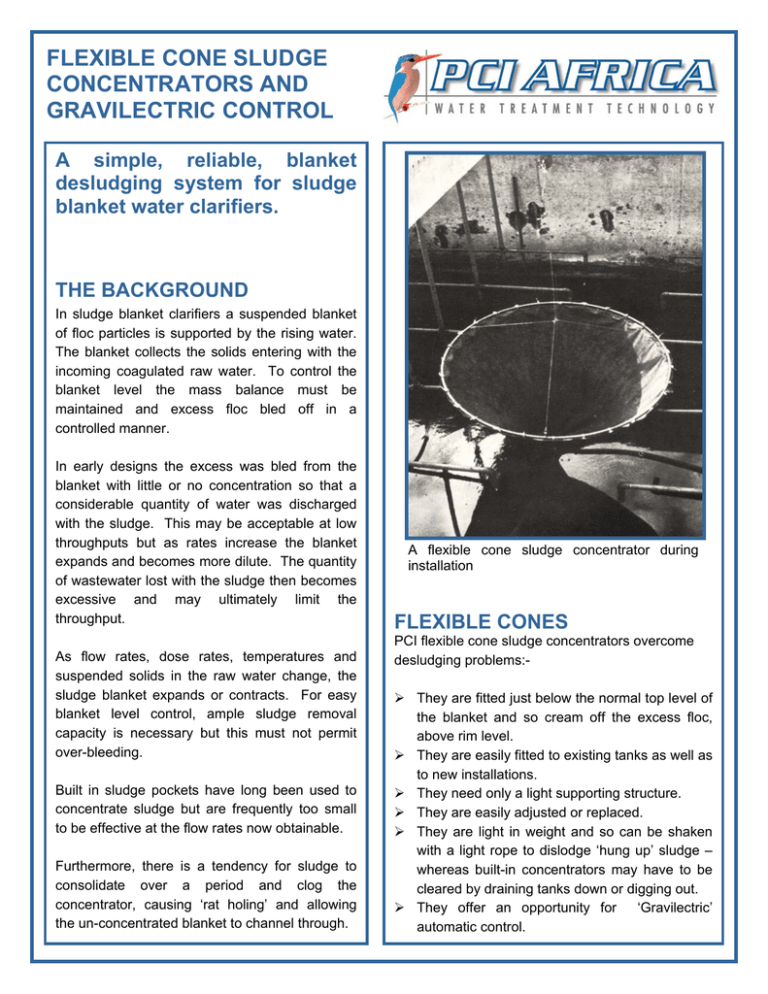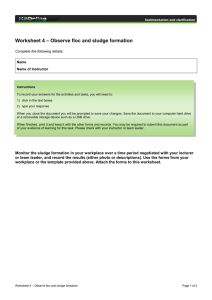FLEXIBLE CONE SLUDGE CONCENTRATORS AND
advertisement

FLEXIBLE CONE SLUDGE CONCENTRATORS AND GRAVILECTRIC CONTROL A simple, reliable, blanket desludging system for sludge blanket water clarifiers. THE BACKGROUND In sludge blanket clarifiers a suspended blanket of floc particles is supported by the rising water. The blanket collects the solids entering with the incoming coagulated raw water. To control the blanket level the mass balance must be maintained and excess floc bled off in a controlled manner. In early designs the excess was bled from the blanket with little or no concentration so that a considerable quantity of water was discharged with the sludge. This may be acceptable at low throughputs but as rates increase the blanket expands and becomes more dilute. The quantity of wastewater lost with the sludge then becomes excessive and may ultimately limit the throughput. As flow rates, dose rates, temperatures and suspended solids in the raw water change, the sludge blanket expands or contracts. For easy blanket level control, ample sludge removal capacity is necessary but this must not permit over-bleeding. Built in sludge pockets have long been used to concentrate sludge but are frequently too small to be effective at the flow rates now obtainable. Furthermore, there is a tendency for sludge to consolidate over a period and clog the concentrator, causing ‘rat holing’ and allowing the un-concentrated blanket to channel through. A flexible cone sludge concentrator during installation FLEXIBLE CONES PCI flexible cone sludge concentrators overcome desludging problems:¾ They are fitted just below the normal top level of the blanket and so cream off the excess floc, above rim level. ¾ They are easily fitted to existing tanks as well as to new installations. ¾ They need only a light supporting structure. ¾ They are easily adjusted or replaced. ¾ They are light in weight and so can be shaken with a light rope to dislodge ‘hung up’ sludge – whereas built-in concentrators may have to be cleared by draining tanks down or digging out. ¾ They offer an opportunity for ‘Gravilectric’ automatic control. FLEXIBLE CONE SLUDGE CONCENTRATORS CONE CONSTRUCTION Flexible cones are fabricated from a proofed, heavy duty, synthetic, rot-proof fabric supported from a suspension ring and equipped with a collector and discharge hose. Pivotted Arm Concrete or Steel Beam Safety – Flexible cones will adequately support all sludge loadings but will not, of course, support a corresponding volumes of water should the tank be emptied. When correctly operated this cannot occur but, to prevent damage in case of maloperation, the cones can be equipped with an overload release device. Suspension Beam “Gravilectric Load Cell FABRIC CONE FLEXIBLE HOSE Sludge Drain Via Power Operated Valve CONTROL Flexible cone sludge operated in three ways:- concentrators may be Reliable, but requires frequent manual adjustment if wastage is to be avoided, particularly with varying flow rates and water quality. Continuous Bleed – Simple, but wasteful. Throttling down often leads to choking and blockage. Suitable for remote sites where sludge disposal is no problem and electricity is not available. Timer Operation – Better than continuous bleed. A timer operates a motorised valve allowing full bore discharge when required, minimising any chance of blocking. Gravilectric Control – The ultimate in economy giving high and consistent sludge concentration with minimum water wastage. Sludge is discharged only when required and the discharge rate matches changes in flow, dose and raw water solids. GRAVILECTRIC CONTROL OPTIONS This simple, robust system represents a major advance in clarifier operation. The flexible cone / Gravilectric control system may be used:- The light-weight flexible cone is suspended from a 1 On its own (as in a single hopper tank). 2 As a master unit controlling both its own discharge valve and those of other slave flexible cone concentrators. 3 As a master unit controlling built-in lower level concentrators, usually by initiating a time controlled system. 4 In conjunction with lock-out circuits, in multiple clarifier installations, to prevent simultaneous discharge (in the event of an increase in flow through a works for example) where this would prove embarrassing in sludge handling. bell crank unit which transmits the gross weight to a “steelyard” type of load switch mounted in an accessible position at the side of the clarifier. The tripping weight is readily adjusted (although once set seldom needs changing) and an adjustable differential setting controls the weight of sludge discharged at each cycle. Electrical actuation is initiated by a sealed weatherproof switch. The motorised valve may be chosen to suit customer’s requirements, although an electrically actuated valve is normally supplied. The “Gravilectric” control unit, showing the shaker rope (for dislodging consolidated sludge) and the cone suspension wire. EXPERIENCE In the course of extensive trials with flexible cones it has proved possible to reduce sludge discharges by a factor of ten in extreme cases and commonly by three or more depending on circumstances. Again, depending on conditions previously existing, it has frequently been possible to double clarifier throughputs without incurring excessive sludge bleed rates and without significant changes in chemical treatment. UPRATING EXISTING CLARIFIERS WITH FLEXIBLE SLUDGE CONES In recent years it has become common to explore The the potential for uprating existing clarifiers rather overcomes these sludge removal limitations and, than to move direct to an extension. Four factors compared with other measures available for have to be considered, namely: uprating the hydraulic PCI flexible clarifiers, cone the sludge concentrator flexible cone and capacity, the hydraulic stability, the floc settling Gravilectric system has proved remarkably cost- rate and the sludge mass balance. effective. In many cases it has proved possible to remove If uprating is to be successful, there are many bottlenecks and adjust the hydraulic arrangement factors to be taken into account, including minor at relatively small cost. Floc settlement rates but important modifications to the clarifier. PCI have tended to be less of a restriction than might assesses each situation and advises accordingly. have been supposed – especially since one of the If required, equipment can be hired for evaluation wide range of polyelectrolytes now available and exploration of uprating potential of existing usually has dramatic effects. Surprisingly, control plants, and pilot plant supplied to demonstrate of the removal of sludge has often proved to be high rate clarification for new schemes. the limiting factor in uprating clarifiers. NOTE – Flexible cone concentrators are not suitable for use in the ‘once through’ horizontal-type or Centrifloc-type clarifiers, which do not form sludge blankets. PCI AFRICA Paterson Candy International (SA) (PTY) Limited t/a PCI AFRICA | Company Registration Number 53/001821/07 P O Box 308, North Riding, 2162, RSA | 11 Ridge Road, Laser Park, Honeydew| Ⓣ +27 11 794 5004 Ⓕ +27 11 794 6357



